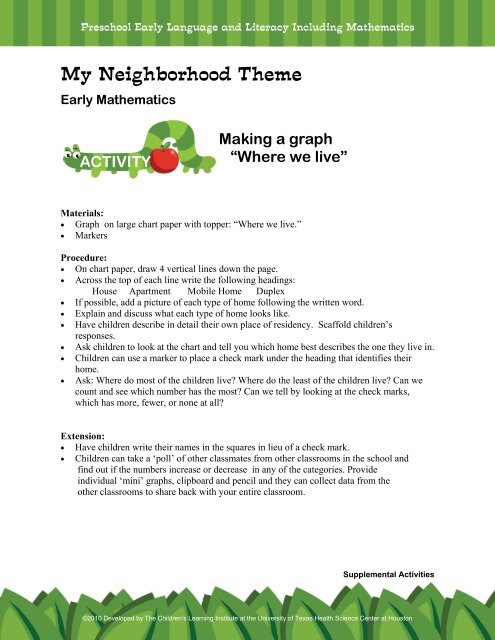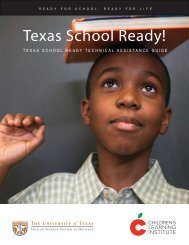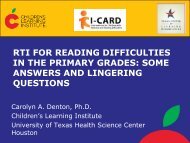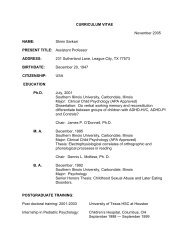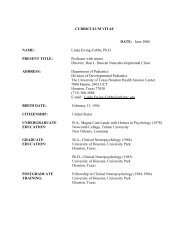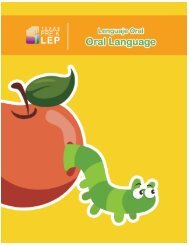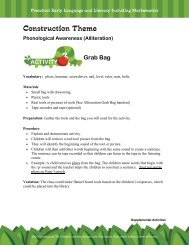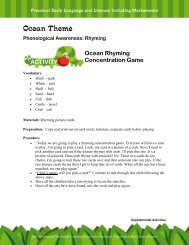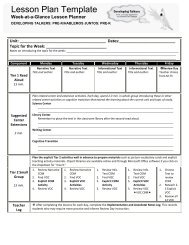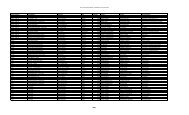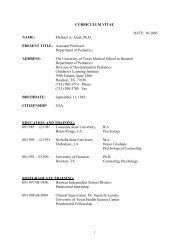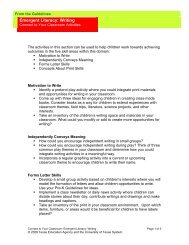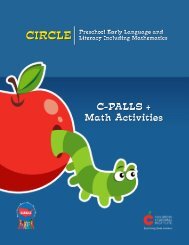My Neighborhood Theme - Children's Learning Institute
My Neighborhood Theme - Children's Learning Institute
My Neighborhood Theme - Children's Learning Institute
You also want an ePaper? Increase the reach of your titles
YUMPU automatically turns print PDFs into web optimized ePapers that Google loves.
Preschool Early Language and Literacy Including Mathematics<br />
<strong>My</strong> <strong>Neighborhood</strong> <strong>Theme</strong><br />
Early Mathematics<br />
ACTIVITY<br />
Making a graph<br />
“Where we live”<br />
Materials:<br />
Graph on large chart paper with topper: “Where we live.”<br />
Markers<br />
Procedure:<br />
On chart paper, draw 4 vertical lines down the page.<br />
Across the top of each line write the following headings:<br />
House Apartment Mobile Home Duplex<br />
If possible, add a picture of each type of home following the written word.<br />
Explain and discuss what each type of home looks like.<br />
Have children describe in detail their own place of residency. Scaffold children’s<br />
responses.<br />
Ask children to look at the chart and tell you which home best describes the one they live in.<br />
Children can use a marker to place a check mark under the heading that identifies their<br />
home.<br />
Ask: Where do most of the children live Where do the least of the children live Can we<br />
count and see which number has the most Can we tell by looking at the check marks,<br />
which has more, fewer, or none at all<br />
Extension:<br />
Have children write their names in the squares in lieu of a check mark.<br />
Children can take a ‘poll’ of other classmates from other classrooms in the school and<br />
find out if the numbers increase or decrease in any of the categories. Provide<br />
individual ‘mini’ graphs, clipboard and pencil and they can collect data from the<br />
other classrooms to share back with your entire classroom.<br />
Supplemental Activities<br />
©2010 Developed by The Children’s <strong>Learning</strong> <strong>Institute</strong> at the University of Texas Health Science Center at Houston
Preschool Early Language and Literacy Including Mathematics<br />
<strong>My</strong> <strong>Neighborhood</strong> <strong>Theme</strong><br />
Early Mathematics<br />
ACTIVITY<br />
Materials:<br />
Chart paper<br />
Markers and or crayons<br />
Counting bears<br />
Math Stories<br />
A <strong>Neighborhood</strong><br />
Adventure Story!<br />
Procedure:<br />
On a large sheet of chart paper draw a small neighborhood. On the left side of the street draw and<br />
label a red house, a green house and a blue house. On the right side of the street draw and label a<br />
yellow house, a brown house and a playground. You can also add other features such as the street,<br />
trees, grass, sidewalks etc.<br />
To model the process, tell the children, “I am going to tell you a story about the little bears great<br />
neighborhood adventure. One day two bears left their red house and went to their neighbor bear’s<br />
house that lived in the green house. (Children place two bears on the red house and then ‘walk’<br />
down the street to the green house) They knocked on the door but no one was home. “How many<br />
bears are in the green house” Children respond. Provide assistance as needed for children to place<br />
bears in the houses and count them. Next, they went to the house next door, the blue house. Again<br />
no one was home.. Ask, “How many bears are in the blue house” Children respond. Assist as<br />
needed.<br />
The two bears continued on their journey. They looked carefully across the street; first they looked<br />
left, then they looked right. When they saw that the road was clear they crossed the street and went<br />
to the yellow house. Two bears came out of the yellow house to join them. “How many bears are<br />
there now” Children respond. (They should add two bears to the yellow house and cluster the four<br />
bears together as they now continue the adventure). The four bears now together walked to the<br />
brown house. They knocked on the door but again no one answered because no one was at home.<br />
The four bears continued to the playground. (Have the children ‘walk’ the 4 bears to the<br />
playground). To their great delight, they found their 3 friends from the neighborhood at the<br />
playground. (Add three bears on to the playground). How many bears are there now Ask what will<br />
the bears do next<br />
Extension: You may want to start with fewer bears or create a smaller neighborhood with fewer<br />
houses on the block. This activity is best implemented in a small group setting<br />
Supplemental Activities<br />
©2010 Developed by The Children’s <strong>Learning</strong> <strong>Institute</strong> at the University of Texas Health Science Center at Houston
Preschool Early Language and Literacy Including Mathematics<br />
<strong>Neighborhood</strong> <strong>Theme</strong><br />
Early Mathematics<br />
ACTIVITY<br />
Shape Houses<br />
Materials:<br />
Assorted shapes in various sizes such as rectangles, squares, circles, and triangles<br />
Plain sheets of paper; one for each child<br />
Glue<br />
Procedure:<br />
Discuss the basic components of a house: the building structure, entrance door, windows,<br />
chimney, roof, etc. Show real pictures of different types of houses.<br />
<br />
<br />
<br />
Provide assorted shapes in various sizes such as rectangles, squares, circles, and triangles.<br />
Identify the name of each shape and discuss the attributes such as the number of sides. Ask<br />
if some of the shapes look like things they might see on a house; i.e. the rectangle looks like<br />
the same shape as a door.<br />
Ask the children to create a house using the shapes provided. They can glue the shapes on to<br />
the paper. Provide children with items to add additional features such as more windows,<br />
chimney, garage, and a sidewalk.<br />
Once the house is built ask children to count the number of windows they have on their<br />
house, doors, walls, etc.<br />
Supplemental Activities<br />
©2010 Developed by The Children’s <strong>Learning</strong> <strong>Institute</strong> at the University of Texas Health Science Center at Houston


